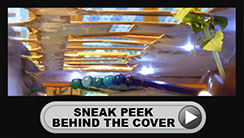
By Hiba Giacoletto, Wiser Humans
Connection is why we're here; it is what gives purpose and meaning to our lives. - Brené Brown
A few months ago, my 11 year marriage broke-up.
Like all humans, I need connection. I crave connection. I can’t live without connection.
Learning to be just me after 15 years of being a couple, I needed to redefine connection.
I had heard Barbara Fredrickson speak about her research on Love 2.0 at a conference and I really related to her way of reframing love.
Her idea is that love is about so much more than romantic connections.
As she writes:
Love is not romance. It's not sexual desire. It's not even that special bond you feel with family or significant others.
Instead Fredrickson defines love as micro-moments of shared connection that we can have with anyone, anywhere:
Laughing with a friend. Connecting with a stranger on a bus. Playing with a baby. Saying goodbye to someone at the airport.
These micro-moments add up throughout our days, weeks, months, years to contribute greatly to our physical and emotional well-being at least as much, if not more, than romantic relationships.
There is actual physical magic that happens when we experience even just a few seconds of connecting with someone.
Connection is an energy between people that nourishes us emotionally and physically.
And it isn’t just true for positive moments - it works for difficult moments as well. As long as we are able to convey empathy, compassion or appreciation, we can also experience micro-moments of connection even in the midst of suffering.
As Fredrickson writes:
Evidence suggests that when you really click with someone else, a discernible yet momentary synchrony emerges between the two of you, as your gestures and biochemistries, even your respective neural firings, come to mirror one another in a pattern I call positivity resonance. Love is a biological wave of good feeling and mutual care that rolls through two or more brains and bodies at once.
So how can we have more of these micro-moments? How can we create the connection we crave with people, but are often afraid to open up to?
I have been putting into practise this idea of micro-moments of connection for the past few months and it really has made all the difference.
Based on Fredrickson’s research there are two conditions necessary for micro-moments of connection to happen:
1. We need to feel safe.
This sounds strange, yet totally makes sense. It is only when we feel safe enough to open up and share a part of us that we can truly connect with others.
When we are stressed, hurrying, buying into the fear that others might reject us or not respond to our attempts to connect, it is hard to feel safe.
In order to feel safe, I find it important to give others permission not to respond to your bid for connection. It probably isn’t about you anyway. They may not be open to connecting right now, and that’s OK. It will be a part of the process.
2. Physical presence, particularly eye contact
According to research, more than touch or vocalisation or anything else, eye contact is what sets off the physical cascade of positive effects - the feeling of being connected to someone.
Once these two conditions are met, for me, the most important thing is:
Simply being open to connecting with someone and being fully present, even for just a few seconds.
Because connection is everywhere, and possible with anyone - from a stranger to a friend or colleague or family member.
What I find works well:
- Being genuinely curious about the other person
- Being warm
- Being willing to share something about yourself that feels appropriate for the situation.
There is no magic recipe. It will depend on the situation and on your personal preference. Some people are good at using humor. Others prefer asking questions. Some prefer sharing a little about themselves. It’s about finding your personal style!
Here are some examples of micro-moments of connections I have experienced recently:
- Asking the taxi driver what the story behind his tattoo is.
- Commenting on the cool nail polish of the grocery store cashier.
- Commenting to the hurried waitress at the café how stressful it must be for her to deal with everyone arriving at the same time.
Isn’t this a much more accessible way of thinking about love and connection?
Because connection is possible everywhere when we open up to it.
Download your free PDF: 7 Life-Changing Facts about Emotions
Author's bio

Hiba Giacoletto is a Psychologist and Coach working in Geneva, Lausanne and online.
A Swiss-Jordanian mix, she has a Masters Degree in Psychology from the University of Lausanne and is a certified Integrative Nutrition Health Coach from the Institute for Integrative Nutrition (IIN). She previously ran Healthwise.ch, a health coaching business where she also created healthy recipes.
Hiba uses mindfulness-based behavioural approaches such as Acceptance and Commitment Therapy (ACT) and Compassion Focused Therapy (CFT). These are more active forms of therapy where, more than just talk, you learn skills for living.
She specializes mostly in difficulties around relationships, emotions, making healthy change and eating, and also offers group sessions, both in-person in Geneva/Lausanne and online.
www.wiserhumans.com
fb.me/wiserhumans









